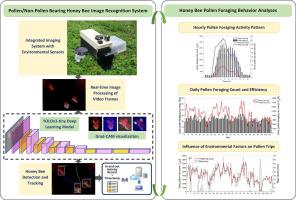Computers and Electronics in Agriculture ( IF 7.7 ) Pub Date : 2021-06-09 , DOI: 10.1016/j.compag.2021.106239 Thi Nha Ngo , Dan Jeric Arcega Rustia , En-Cheng Yang , Ta-Te Lin

|
Pollen foraging efficiency provides vital information for the behavioral research on honey bees. The pollen production of beehives can be measured by manually weighing the pollen collected from pollen traps. For long-term pollen foraging monitoring, this approach is both inefficient and laborious. This study presents an efficient method for automatically monitoring the pollen foraging behavior and environmental conditions through an embedded imaging system. The imaging system uses an off-the-shelf camera installed at the beehive entrance to acquire video streams that are processed using the developed image processing algorithm. A lightweight real-time object detection and deep learning-based classification model, supported by an object tracking algorithm, was trained for counting and recognizing honey bee into pollen or non-pollen bearing class. The F1-score was 0.94 for pollen and non-pollen bearing honey bee recognition, and the precision and recall values were 0.91 and 0.99, respectively. For foraging trip counting algorithm, the mean average percent errors of the pollen bearing honey bee count and the total incoming honey bee count were 8.45 ± 2.72% and 10.55 ± 2.10%, respectively. An experiment was performed to test the performance of the imaging system in continuous monitoring of honey bee pollen foraging behavior as well as to investigate the effect caused by weather factors. The incoming and outgoing honey bee count were recorded and used to calculate indices based on the hourly and daily recorded counts for further analyses. The experimental results and analyses revealed that the daily pollen foraging trip ratio was 24.5 ± 3.5%; a single beehive collected about 49.1 ± 11.0 g of pollen per day. The pollen foraging trip count increased with increasing temperature and light intensity, and decreased with increasing relative humidity, rain level and wind speed. A significant reduction of pollen foraging activities was observed in heavy rainfall or gentle breeze conditions. This study not only quantitatively presents the effect of environmental factors on pollen foraging behavior, but also demonstrates the efficacy of the proposed imaging system. The automated imaging system can be applied as an efficient and reliable tool for researchers to gain deeper insights into honey bee foraging behavior, and help beekeepers achieve beehive management.
中文翻译:

使用基于深度学习的成像系统自动监测和分析蜜蜂花粉觅食行为
花粉觅食效率为蜜蜂的行为研究提供了重要信息。蜂箱的花粉产量可以通过手动称重从花粉陷阱收集的花粉来测量。对于长期花粉觅食监测,这种方法既低效又费力。本研究提出了一种通过嵌入式成像系统自动监测花粉觅食行为和环境条件的有效方法。成像系统使用安装在蜂巢入口处的现成摄像头来获取使用开发的图像处理算法处理的视频流。一个轻量级的实时对象检测和基于深度学习的分类模型,由对象跟踪算法支持,被训练用于计数和识别蜜蜂进入花粉或非花粉类。花粉和无花粉蜜蜂识别的 F1 分数为 0.94,准确率和召回值分别为 0.91 和 0.99。对于觅食旅行计数算法,带花粉的蜜蜂计数和总传入蜜蜂计数的平均平均百分比误差分别为 8.45 ± 2.72% 和 10.55 ± 2.10%。进行了一项实验,以测试成像系统在连续监测蜜蜂花粉觅食行为方面的性能以及研究天气因素造成的影响。记录进出蜜蜂的数量,并根据每小时和每天记录的数量计算指数,以供进一步分析。实验结果和分析表明,每日花粉觅食率为24.5±3.5%;一个蜂箱收集了大约 49.1 ± 11。每天0克花粉。花粉觅食次数随着温度和光照强度的增加而增加,随着相对湿度、雨量和风速的增加而减少。在强降雨或微风条件下观察到花粉觅食活动显着减少。这项研究不仅定量地呈现了环境因素对花粉觅食行为的影响,而且还证明了所提出的成像系统的功效。该自动化成像系统可以作为一种高效可靠的工具,让研究人员深入了解蜜蜂的觅食行为,并帮助养蜂人实现蜂箱管理。在强降雨或微风条件下观察到花粉觅食活动显着减少。这项研究不仅定量地呈现了环境因素对花粉觅食行为的影响,而且还证明了所提出的成像系统的功效。该自动化成像系统可以作为一种高效可靠的工具,让研究人员深入了解蜜蜂的觅食行为,并帮助养蜂人实现蜂箱管理。在强降雨或微风条件下观察到花粉觅食活动显着减少。这项研究不仅定量地呈现了环境因素对花粉觅食行为的影响,而且还证明了所提出的成像系统的功效。该自动化成像系统可以作为一种高效可靠的工具,让研究人员深入了解蜜蜂的觅食行为,并帮助养蜂人实现蜂箱管理。











































 京公网安备 11010802027423号
京公网安备 11010802027423号